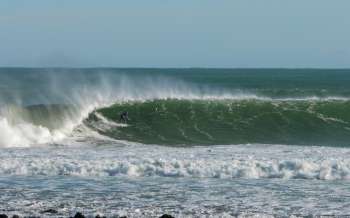How to Measure Wave Size
You'd imagine it was pretty simple - you look out to sea, someone is riding a wave, it's 3 feet (1 metre) above there head and they are 6ft (2 metres) tall - obviously that is a 9 foot (2.8 metre) wave! Well unfortunately it isn't always that straightforward.
The way in which surfers measure wave height varies depending on who you ask and where they are from. Here on the Beach Guide we actually employ 2 methods of measuring wave size. For our surf reports we go by face height, i.e. the measurement from trough to crest of the wave. However, on the spot descriptions we use the more colloquial "from the back" method which most surfers understand although it is subject to regional interpretation, guess work and exaggeration!
Despite having few redeeming features th from the back method is the general rule throughout the surfing world. But it wasn't always this way and there are indications that it might not reamin this way for ever. So where did this seemingly bizarre way of measuring waves originate? The answer is thought to be Hawaii's North Shore, although the exact whens and whys are a little hazy:
The "Hawaiian Scale" theoretically measures the wave from the back but in practice is more a matter of dividing the face height in half. So a head-high wave would be around 3ft Hawaiian style - of course! This wan't always the case, in the old days waves were measured by face size, so why the change?
Well one theory is the back of the wave is a measure of the swell and not a reflection of the paticular break, i.e a 6ft swell is going to produce a bigger wave on a shallow slab than a sloping beach.
Others suggest that measuring waves from the back started as some sort of way of keeping the crowds down by giving a surf report that those not in the know would regard as not worth the trouble. There is certainly some evidence that the North Shore lifeguards used this clandestine way of measuring waves to their advantage, keeping the breaks queiter thus decreasing their work load and increasing their surf time! In fact it may have been an even more widespread rivalry between the North Shore (Country) and "townies", with the Country guys calling it smaller. The evidence for this is that even in Hawaii these 2 groups call the size slightly differently.
There is also a further factor - the tendency of some surfers to call it smaller so they appear more heroic! This is reinforced by a fear of calling it bigger than one's peers would. A fine example of this was from the Eddie Aikau Quicksilver Waimea big wave contest when the judges were asked how big it was. After a long silence one of the judges said "Overhead!".
Anyway, whatever the exact origin of this frankly bizarre way of measuring waves, 50 years on it is pretty well established (with regional variations). Just check any of the global surf media.
Outside of Hawaii it is more likely the measurement will more likely be around 2/3 the face height just to add confusion.
The example that has really broken this system is Teahupoo. It's a wave without a back! It can be double head high on the face and barely have a back. How do you call that?!
There are some signs that reason may win the day though, or more to the point litigation. The fear that someone will sue a forecaster for calling a 10 foot wave 5 foot has prompted the National Weather Service in Honolulu and much of the Hawaiian media to start using face size in their reports.
One further nuance about wave sizes is the ranges used. You can have 1-2ft, 2-3ft, 2-4ft, 4-6ft but you don't get 5-7ft and 9ft is pretty much unheard of!
Table showing various ways of measuring wave size
| Face height | Hawaiian Scale | Rest of World | Relative | Photo |
|---|---|---|---|---|
| 3ft/1m | 1-2ft | 2ft | Waist-high |  |
| 5ft/1.5m | 2-3ft | 3ft | Shoulder-high |  |
| 8ft/2.5m | 4ft | 4-5ft | Overhead |  |
| 10ft/3m | 5ft | 6ft | 4ft Overhead |  |
| 12ft/4m | 6ft | 8ft | Double overhead |  |
| 16ft/5m | 8ft | 10-12ft | Triple overhead |  |
| 20ft/7m + | 10ft | 15ft | Huge!! |  |
-
Montalivet Naturist Beach // France

©ecowez Montalivet sits midway along France's Atlantic coast. The region is characterised by seemingly endless stretches of sand backed by dunes and forest beyond. The nude beach at Montalivet (Plage Naturiste de Montalivet) makes up a comparatively modest 2 kilometres of this sandy expanse.
A stone's throw from Bordeaux the beach backs onto what is said to be the world's first naturist resort. Dating back to 1950 the CHM Montalivet (Monta) sprawls over 200 hectares accommodating up to 10,000 visitors in its camping grounds and apartments.
Here you can do everything in the… read more »







